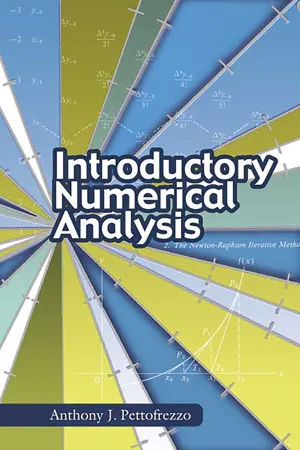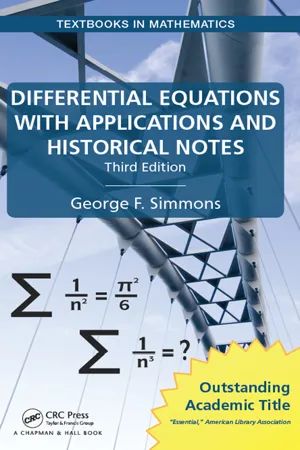Mathematics
Euler's Method
Euler's Method is a numerical technique used to approximate the solutions of ordinary differential equations. It involves breaking down the differential equation into small steps and using the tangent line at each step to approximate the next value. While it is a simple and intuitive method, it may not always provide highly accurate results, especially for complex equations.
Written by Perlego with AI-assistance
Related key terms
5 Key excerpts on "Euler's Method"
- eBook - ePub
- Anthony J. Pettofrezzo(Author)
- 2012(Publication Date)
- Dover Publications(Publisher)
3. EULER’S METHODOne of the simplest numerical procedures for obtaining particular solutions of the first-order differential equation y′ = f (x , y ) in a relatively small region of the xy -plane about a given point (x 0 , y 0 ) is attributed to Euler. The graphical method which was studied in Section 8.2 for solving a first-order differential equation is the geometrical equivalent of Euler’s method.Euler’s method involves a linear extrapolation along the tangent line to an integral curve passing through (x 0 , y 0 ). The first step of this method is to determine an increment Δy of the dependent variable for some arbitrary increment Δx of the independent variable from the given point (x 0 , y 0 ). Since8 .68.7Then8.8where (x 1 y 1 ) represents the coordinates of a second point on the integral curve y’ = f (x, y ) passing through (x 0 , y 0 ) such that x 1 = x 0 + Δx 0 . A repetition of the process yields an approximation to a third point (x 2 , y 2 ) on the integral curve, where x 2 = x 1 + Δx 1 andy 2 = y 1 + Δy 1 ≈ y 1 + f (x 1 , y 1 ) Δx 1 .Note that the y 1 used here is equal to the approximation obtained in (8.8) since we cannot obtain the exact value of y 1 . In general, an approximation to the coordinates of an (n + 1)th point on the integral curve is obtained by using the recursion formulas8.98.10and is called Euler’s method. In calculating a set of approximations to the points on a particular integral curve, Δx i is usually chosen as some convenient constant for all values of i . Hereafter, we shall omit the subscripts for Δx i in such instances.Furthermore, we shall write8.11when using Euler’s method, noting that y n is an approximation. In discussing other numerical procedures, it will often be convenient to use the equal sign for an approximation. The context of the discussion will usually denote when an approximation is implied.EXAMPLE 1. Approximate the particular solutions over the interval 0 ≤ x ≤ 1 of the differential equation y′ = y − x through (0, 2). Let Δx - eBook - ePub
Differential Equations
Theory,Technique and Practice with Boundary Value Problems
- Steven G. Krantz(Author)
- 2015(Publication Date)
- Chapman and Hall/CRC(Publisher)
Chapter 4Numerical Methods
- The idea of a numerical method
- Approximation
- Error terms
- Euler’s method
- Improved Euler method
- Runge-Kutta method
The presentation in this book, or in any standard introductory text on differential equations, can be misleading. A casual reading might lead the student to think that “most” differential equations can be solved explicitly, with the solution given by a formula. Such is not the case. Although it can be proved abstractly that most any ordinary differential equation has a solution—at least locally—it is in general quite difficult to say in any explicit manner what the solution might be. As we saw in Chapter 3 , it is sometimes possible to say something qualitative about solutions. And we have also seen that certain important equations that come from physics are fortuitously simple, and can be attacked effectively. But the bottom line is that many of the equations that we must solve for engineering or other applications simply do not have closed-form solutions. Just as an instance, the equations that govern the shape of an airplane wing cannot be solved. Yet we fly every day. How do we come to terms with the intractability of differential equations?The advent of high-speed digital computers has made it both feasible and, indeed, easy to perform numerical approximation of solutions. The subject of the numerical solution of differential equations is a highly developed one, and is applied daily to problems in engineering, physics, biology, astronomy, and many other parts of science. Solutions may generally be obtained to any desired degree of accuracy, graphs drawn, and any desired analysis performed.Not surprisingly—and like many of the other fundamental ideas related to calculus—the basic techniques for the numerical solution of differential equations go back to Newton and Euler. This is quite amazing, for these men had no notion of the computing equipment that we have available today. Their insights were quite prescient and powerful. - James F. Epperson(Author)
- 2013(Publication Date)
- Wiley(Publisher)
There are two main derivations; one is geometric, the other is analytic, and a third derivation (the one we used in Chapter 2) is given in §6.4. We start with the geometric derivation.Consider Figure 6.1 . This shows the graph of the solution y(t) to the initial value problemFigure 6.1Geometric derivation of Euler’s method.near the initial point t0 . All we know about y is that it passes through the point (t0 , y0 ) = (0, 0), and that it has slope f(t0 , y0 ) (why?) at that point. We therefore can approximate y(t + h) for some small h by using the tangent line approximation:(6.10)For small values of h this will be a decent approximation, and if we define the next point in our grid by t1 = t0 + h, then it is very natural to extend (6.10) to get(6.11)or, more generally,(6.12)The numerical method is then defined from (6.12) according towith y0 given and yn≈ y(tn).This is a reasonable and easy-to-follow derivation, but it does not admit of much error analysis, and it also opens up a lot of questions. Perhaps the most important such question concerns the validity of extending the tangent line approximation from the first computed point, (t1 , y1 ), to the next one. From the graph in Figure 6.1 , it is clear that there is substantial error between y1 and y(t1 ). How valid, then, is (6.11) in defining the next approximate point?The analytic derivation is based, to no surprise, on Taylor’s Theorem. We have thatfor some θ between t and t + h. But the differential equation implies that y′(t) = f(t, y(t)), so we have(6.13)Now set t = t0 , define tn+1= tn+ h, set ynto be the approximate value, and drop the remainder to get the same expression that we had before:(6.14)The advantage of this derivation is that we have (6.13)- eBook - ePub
Differential Equations
A Modern Approach with Wavelets
- Steven Krantz(Author)
- 2020(Publication Date)
- Chapman and Hall/CRC(Publisher)
5Numerical Methods
• The idea of a numerical method • Approximation • Error terms • Euler’s method • Improved Euler method • Runge–Kutta methodThe presentation in this book, or in any standard introductory text on differential equations, can be misleading. A casual reading might lead the student to think that “most” differential equations can be solved explicitly, with the solution given by a formula. Such is not the case. Although it can be proved abstractly that most any ordinary differential equation has a solution—at least locally—it is in general quite difficult to say in any explicit manner what the solution might be. It is sometimes possible to say something qualitative about solutions. And we have also seen that certain important equations that come from physics are fortuitously simple, and can be attacked effectively. But the bottom line is that many of the equations that we must solve for engineering or other applications simply do not have closed-form solutions. Just as an instance, the equations that govern the shape of an airplane wing cannot be solved. Yet we fly every day. How do we come to terms with the intractability of differential equations?The advent of high-speed digital computers has made it both feasible and, indeed, easy to perform numerical approximation of solutions. The subject of the numerical solution of differential equations is a highly developed one, and is applied daily to problems in engineering, physics, biology, astronomy, and many other parts of science. Solutions may generally be obtained to any desired degree of accuracy, graphs drawn, and any desired analysis performed.Not surprisingly—and like many of the other fundamental ideas related to calculus—the basic techniques for the numerical solution of differential equations go back to Newton and Euler. This is quite amazing, for these men had no notion of the computing equipment that we have available today. Their insights were quite prescient and powerful. - George F. Simmons(Author)
- 2016(Publication Date)
- Chapman and Hall/CRC(Publisher)
2 , etc. Our general purpose is to apply enough of the details of each method to enable the reader to apply it for himself if the need should ever arise. We avoid details dealing with the plethora of computing machines and programming languages for several reasons. First, those issues are best left to specialized texts in numerical analysis. Second, it is our experience that virtually all students have some familiarity with computing fundamentals and should be able to write programs where appropriate to perform the calculations required by the exercises in this chapter. As to the means, that is better left to the student and his teacher. Third, advances in computing continue at a dizzying pace, and we see no need to burden this book with nonmathematical details that might well be obsolete in only a few short years.We shall illustrate our methods by applying them to the simple problemy ′= x + y , y( 0 )= 1 ,(3) which we call our benchmark problem. This differential equation in (3) is clearly linear, and the exact solution is easily found to bey = 2e x− x − 1.(4) We have chosen (3) as our benchmark problem for two reasons. First, it is so simple that a numerical method can be applied to it by hand without obscuring the main steps by a morass of computations. Second, the exact solution (4) can easily be evaluated for various x’s with the aid of a pocket calculator, so we have a means of judging the accuracy of the approximate solutions produced by our numerical methods.Problem
1. Have you encountered any examples in other courses where either the textbook or the instructor referred to numerical solutions of ordinary differential equations? Give an example and discuss what you read or heard.73 The Method of Euler
If we integrate the differential equation in (2) from x0 to x1 = x0 + h, and use the initial condition y(x0 ) = y0
Learn about this page
Index pages curate the most relevant extracts from our library of academic textbooks. They’ve been created using an in-house natural language model (NLM), each adding context and meaning to key research topics.




